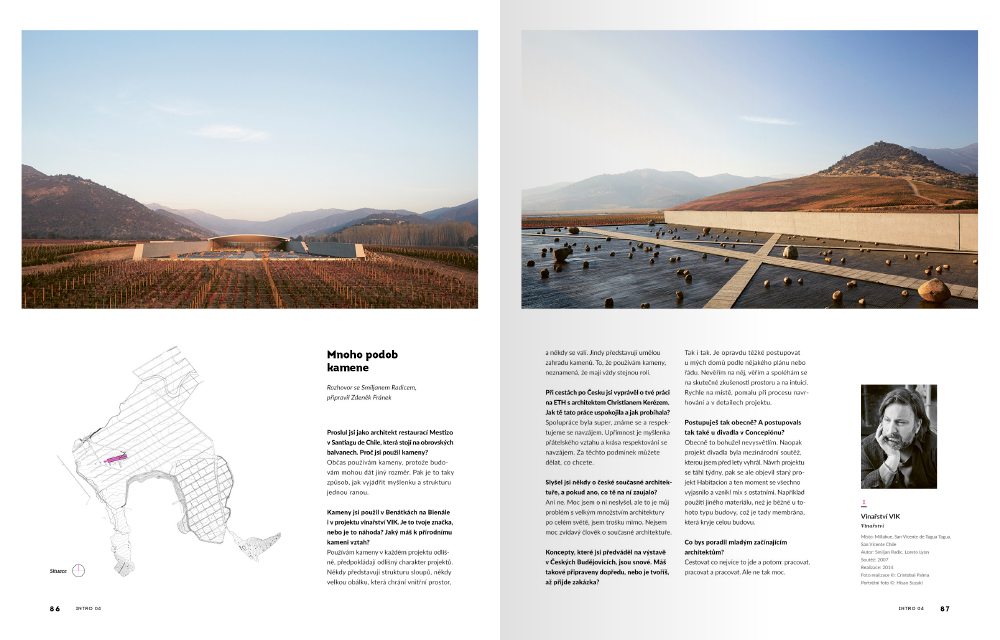Published issues
STONE
“Any natural material that man has worked with from time immemorial is always most effective in its natural form as it occurs in nature. In this state, it is still “alive” and part of the landscape.” These are the words of František Skála, whose introduction kicks off this fourth edition of INTRO magazine, devoted to stone.
Print format 230 × 295 mm, 148 pages
Printed on uncoated, offset paper
Printed in Czech
sold out
EDITORIAL
Together with wattle and clay, stone is perhaps one the most basic building materials, as far back as the history of humanity goes. Yet the current stone edition of INTRO was much harder to put together than the wood, concrete or brick issues. It appears that local contemporary architecture has, to a certain extent, simply turned away from stone. Is this material, as seen in Soran, Cappadocia or Jaipur still usable? Or is it essentially a museum exhibit, a relict of the past with no contemporary application?
The wealth of some societies has introduced a debate around the necessity/correctness of using exclusively local stone and whether or not importing it from Africa or Asia amounts to an ideological transgression. EU regulations currently specify how far from its source stone may be used. Considering the current preference for local resources, it's likely that Villa Tugendhat would come in for criticism today. Ondřej Císler takes up this same theme with Vitruvius, when he describes his journey to China.
China has become a red (Red) thread running through this issue of INTRO. In China, or, more precisely, in Tibet, we found two great constructions. Helpful and accommodating colleagues from creative ateliers there had been faultless in their communication. I had already conducted two interviews with them (you can read them in this issue), when suddenly they went quiet for three weeks. Then, one day, their emails started to come again. That evening, I saw on the news that the Chinese Communist Party’s congress had taken place that very day. Apparently, in the weeks leading up to it university professors and certain other elements of Chinese society were forbidden to communicate with foreign journalists until after the Congress. So there you go.
Another trace of China can be found in the articles by stone masons and architects Ota Černý and Táni Kubiková, who focus on funeral architecture. It resonates once more in Ondřej Císler’s text and finally in the implementation of the cemetery in Dolní Břežany.
Once again, Central Europe is represented by Poland, joined this time by Slovenia. Each of our regular contributors, Monika Arczyńska and Marta Bujanda Miguel, chose buildings worthy of your attention. Then there’s Switzerland, Turkey and Chile….before a return to the Czech Republic with a stone construction at Železný Brod.
To conclude, I would like to thank František Skála for his introduction. I have followed his work, imbued with an endlessly renewing poetics, for many years with great pleasure. Still, the idea to reach out to him came from my son. “You’re writing about stone? Call Skála!”
Martin Verner, Editor in Chief
 read more
read more4/ Natural Functionalism
6/ Stone Archive in Beijing
20/ Interview: Atelier Alter
24/ Perspectives on Stone
26/ Stone Belongs to the State
30/ Natural Stone in the Czech Republic
34/ The Dolní Břežany Cemetery
44/ Interview: Zdenek Sendler
48/ A House in Železný Brod
56/ Stone, International Style
60/ Sancaklar Mosque
72/ An Abbey under a Canopy of Stone
80/ A Winery in Chile
88/ The European Centre of Geological Education
98/ A Compact House in Kras, Slovenia
108/ Niyang River Visitor’s Centre
118/ Travelling to China for Stone
122/ Funeral Architecture Set in Stone
128/ Ayurvedic Medicine Pavillion
132/ Publications
134/ Products
136/ Materials and Technology












